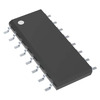Manufacturer Part Number
SN74ALS175D
Manufacturer
Texas Instruments
Introduction
The SN74ALS175D is a quadruple D-type flip-flop with a dedicated master reset feature, part of the Texas Instruments 74ALS series.
Product Features and Performance
D-Type Flip Flop design
Four flip-flops per device
Complementary outputs
Master reset that clears the flip-flops
Positive edge-triggered clock
High-speed operation with a clock frequency of 50 MHz
Product Advantages
Quick propagation delay: 17ns at 5V, 50pF
Low power consumption with 14mA quiescent current
Ability to drive 400µA in the high state and sink 8mA in the low state
Single 5V power supply for ease of design
Surface mount package for modern PCB layouts
Key Technical Parameters
Number of Elements: 1
Number of Bits per Element: 4
Clock Frequency: 50 MHz
Max Propagation Delay: 17ns at 5V, 50pF
Current Output High, Low: 400µA, 8mA
Voltage Supply: 4.5V to 5.5V
Operating Temperature: 0°C to 70°C
Quality and Safety Features
Strict compliance with Texas Instruments' manufacturing standards
Operating temperature grade allows for use in commercial temperature environments
Compatibility
Standard 16-SOIC package compatible with widespread surface mount technology
Compatible with other devices in the 74ALS series for easy integration
Application Areas
Digital logic circuits
Data storage and transfer
Communication systems
Process control systems
Computers and computer peripherals
Product Lifecycle
Product Status: Last Time Buy
Potential nearing discontinuation with suggestions to check for replacements or upgrades from manufacturer
Several Key Reasons to Choose This Product
High-speed performance suitable for demanding applications
Low quiescent current aids in creating power-efficient designs
Texas Instruments' reputation for high-quality, reliable components
Master reset feature enables easier control over the logic states
Positive edge-triggered operation provides precise timing control
Broad application use across various electronics systems
Availability of technical support and documentation from Texas Instruments



 SN74ALS174Texas Instruments
SN74ALS174Texas Instruments SN74ALS191NNS
SN74ALS191NNS SN74ALS169BNSRTexas InstrumentsIC BINARY COUNTER 4-BIT 16SO
SN74ALS169BNSRTexas InstrumentsIC BINARY COUNTER 4-BIT 16SO